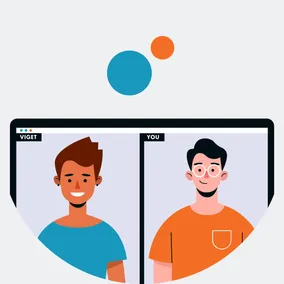Learning from COVID: Remote Interviewing

Erica Licari, Former Senior Recruiter
Article Categories:
Posted on
In response to the COVID-19 pandemic, Viget’s hiring process is fully remote. We’ve compiled some lessons learned about creating a positive candidate experience in spite of the distance.
In order to keep everyone safe during the COVID-19 pandemic, we’re doing all our interviews remotely for now. For the most part, this isn’t a significant change to our process. Typically, our evaluation of candidates is over the phone or via video conference until we get to a final interview stage, when we bring candidates in for in-person interviews. We’ve always prioritized face time at the final stage as a way for us to get to know a candidate better, and for a candidate to get to know Viget, our office space, and their potential coworkers a bit better. Now, however, our final set of interviews happens over video, too.
From a logistics perspective, coordinating a remote interview day is more complicated than a typical in-person interview. While trying to plan for the best possible candidate experience, we're juggling the usual challenges of finding time on busy schedules across multiple time zones, plus pandemic-adjusted availability, and much less visibility in how things are going in real time. The People Team has worked hard to make the logistics of remote interviewing smooth, while still being thorough and effective. We’ve done a few remote interviews over the past month, and we’ve learned a few things along the way. Here are some key takeaways and tips about making the process smooth:
Things we’ve done to make remote interviews effective:
- Offer to break up the interview day to meet the candidate’s needs. The quarantine has affected everyone’s schedules and plenty of candidates have the added stress of working at home with kids, partners, and pets. We want to accommodate candidates’ preferred schedule, even if it’s broken into chunks or across days.
- Ask candidates and interviewers to be camera-ready. This one may seem obvious, but a huge part of a final round interview is giving candidates face time with people they’ll be working with. All the final round interviews are video calls (Google Meet is our default tool), so remind candidates and interviewers that they’ll be on-screen. Ask them to turn on their cameras and tidy up the space around them.
- Give candidates a chance to run through their tech setup before the interview day. Every company has different software they might use, so don’t assume familiarity with the video conferencing tool you’re using.
- Include the candidate on the calendar invite for each session. We include details in the calendar invite about the full schedule. By including a candidate on the invites, they’ll be able to see who they’re meeting with and be able to take a quick glance at the schedule or any changes.
- Show photos of the office. Grace had the great idea to pull up our office on Google Maps during an interview to share some of the photos Andy has taken. It’s not quite the same as seeing our space in person, but gives candidates the chance to see some of our favorite things about the spaces we work in.
- Leave extra time for friendly small talk. Video calls can be awkward, particularly when you don’t know the person you’re speaking with. Intentionally including more time for interviewers and candidates to get to know each other a bit better and reminding interviewers to take advantage of that time has been particularly helpful.
- Substitute a lunch interview. We typically set aside about an hour for candidates to meet with two Vigets in a more relaxed, social setting over lunch. The interview is an opportunity for candidates to learn more about day to day life at Viget. Having lunch over a video call, though, can be uncomfortable. We’ve swapped out our lunch interview for a casual chat over coffee (or tea, if you prefer) later in the day.
- Leave time for breaks. At a typical in-person interview, we wouldn’t be asking a candidate to look at a screen all day. It can be tiring to sit in the same place and look at a screen for an extended period of time. For some interviews, we’ve added a short 15 minute break in between sessions, and for others we’ve included a longer break over the typical lunch hour.
A few things we haven’t done, but have been suggested for some of our next interview sessions:
- Create a slack channel to include the candidate. The biggest touchpoint missing is not knowing if an interviewer is running late or a session is running over. Usually, someone is there in person to help smooth those transitions. For future interviews, we plan on creating a slack channel where the recruiter can let the candidate know in real time what’s happening if there’s a delay. It also gives candidates a space to address any questions they have, or gives them the opportunity to let you know they need a quick water break.
- Create better documentation about what our offices look like. We have photos of the offices and maps of the conference rooms. We hope to get this all in one place.
We’re over a month into our new normal of working fully distributed in response to the COVID-19 pandemic. As we’ve adjusted, we’ve taken comfort in keeping many of the same work routines: doing great client work, coming together as a team, and continuing to hire for a few roles. We’ll likely keep adjusting and making changes over time to this new way of interviewing. While we’d certainly prefer to be meeting everyone in person, we’re lucky to be in the position to do remote interviewing for the time being. If your company has adjusted to fully remote interviews, what tips do you have?